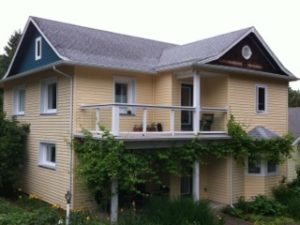Highest-Efficiency HRV without UL Listing for Futurefit Home
Case Study: Published | Updated: | | | 6680- Category
- category_listing(s)
- Building Type
- Residential
- Innovation
- Super-efficient HRV not UL Listed
- Jurisdiction
- Parcel
- 6680
- Officials
- Ben Howell | Bureau of Development Services
Terry Whitehill | Bureau of Development Services - Team
-
Tad Everhart
|
owner
Chip Higgins | owner
Barry Stephens | Other
Matt Groves | Other

To futurefit our home (remodel for the future) to the Passive House Standard, we air sealed to reduce air leakage by a factor of 5. Without this “accidental ventilation” we needed to add balanced, mechanical ventilation with heat recovery. At the time, no UL-listed heat recovery ventilator (HRV) was available with the necessary combination of 75%+ effective heat transfer and low electrical consumption. The ZehnderAmerica CA 350 HRV was certified by the Passivhaus Institut (PHI) for superior performance, but it was not tested and listed by Underwriter’s Laboratory (UL). The City of Portland allowed us to install it without UL listing as an alternate material through its Alternative Technology Advisory Committee (ATAC) process. We enjoy superior ventilation, indoor air quality, and energy efficiency with our HRV.
The City of Portland sanctions the ATAC to review and potentially recommend environmentally-superior building technologies not clearly allowed by building codes. If the applicant is successful, then ATAC recommends (in writing) approval by the building official deciding a building code appeal for the technology. Please note that the BDS appeal approval was predicated on the ATAC’s recommendation. For the underlying ATAC recommendation, see http://www.portlandoregon.gov/bds/48661?a=255008
| Code Requirement | Compliance Path |
|---|---|
| The 2007 Oregon Mechanical Specialty Code (OMSC) requires that mechanical equipment installed or used in a building be tested, listed, and labeled by an approved agency such as Underwriters Laboratory. | Written application for building code appeal based on ATAC’s recommendation; administrative hearing decided by City staff (without applicant present); and written, online approval. |
| 2005 ORSC section R104.11 allows alternative materials, design and methods of construction and equipment when the material or work offered is equivalent | Written application to City’s ATAC, ATAC in -person hearing, and ATAC’s written recommendation. |